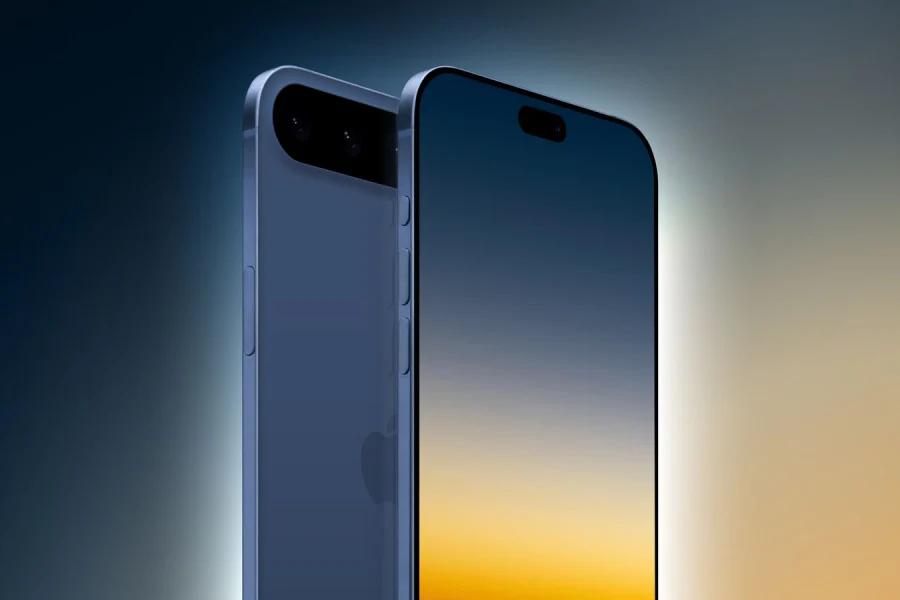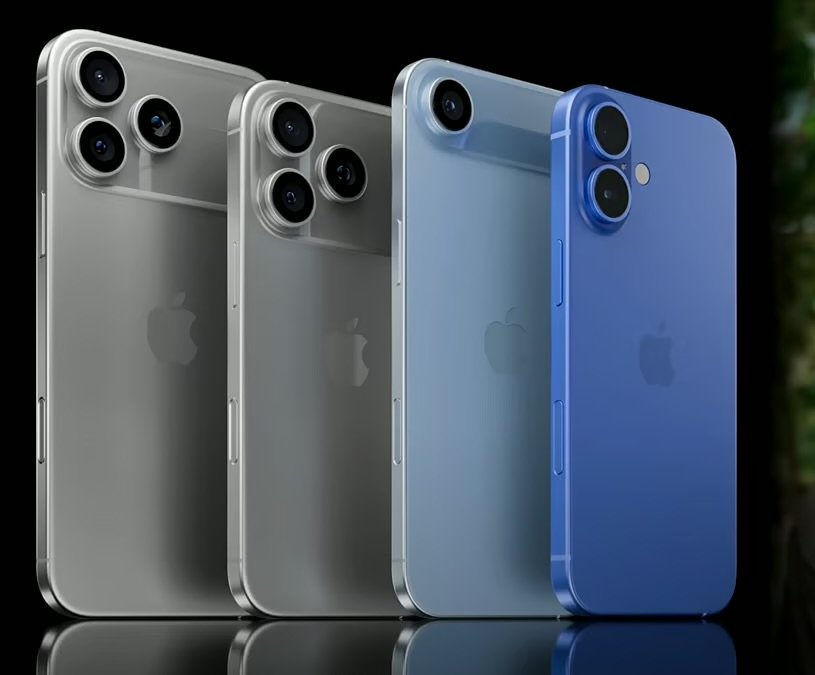The all new IPhone 17 is a leap forward in technology. Apple is tweaking build materials and aesthetics. After using titanium alloy frames on last year’s Pro iPhones, Apple is reportedly reverting to aluminum frames for the iPhone 17 Pro line, which allows for bolder color options . New hues like a vibrant Orange and a deep Dark Blue are rumored for the Pro models alongside the usual black and silver . Meanwhile, the standard iPhone 17 may come in a refreshed palette including black, white, steel gray, green, purple, and light blue , giving consumers plenty of choice.
On the front, display improvements are a headline feature. For the first time, Apple’s non-Pro iPhone will get a high-refresh-rate screen: the iPhone 17 is expected to adopt the same LTPO OLED display with up to 120Hz ProMotion as previous Pro models . This means ultra-smooth scrolling and animations, a feature previously reserved for Pro devices. (The iPhone 16 standard models were still limited to 60Hz displays , a point of criticism for many.) The LTPO technology also enables an Always-On Display capability, which reportedly will also extend to the standard iPhone 17 now . The bezels might be slightly slimmer as well, giving the phone a more edge-to-edge look . For the Pro screens, Apple is rumored to introduce a new anti-reflective and more scratch-resistant glass solution (developed with Corning), improving outdoor visibility and durability . In summary, whether you choose the base model or a Pro, the iPhone 17’s display should be a notable step up in smoothness and resilience.
Camera System and Upgrades
Apple is putting a strong emphasis on the iPhone 17’s camera system, though the upgrades differ between the standard and Pro models. Perhaps the most wide-reaching improvement is in selfies: all iPhone 17 models will feature a new 24‑megapixel front-facing camera, doubling the resolution from the 12MP selfie camera on the iPhone 16 . This higher-resolution front camera should deliver sharper self-portraits and also allows more flexibility for digital zoom/cropping without losing detail . For anyone who frequently uses FaceTime or takes group selfies, this is a significant upgrade in image quality.
On the back, the standard iPhone 17 is expected to carry forward the same dual-camera setup as last year: a 48MP main (wide) lens and a 12MP ultra-wide lens, similar to the iPhone 16’s configuration . Rumors have not pointed to major hardware changes for these lenses on the base model, so image quality should be in line with the previous generation’s, aside from software tweaks. That said, the improved image signal processor in the new A19 chip (discussed later) and iOS 19 software enhancements could still yield better photos, especially in computational photography and low-light scenarios.
It’s the iPhone 17 Pro and Pro Max where camera hardware leaps forward. Most notably, Apple is reportedly upgrading the telephoto lens to a 48MP sensor, up from the 12MP telephoto on the iPhone 16 Pro series . With all three rear cameras now at 48 megapixels (wide, ultra-wide, and telephoto), the Pro models will have greater consistency in sensor resolution. The higher pixel count on the telephoto enables advanced zoom capabilities – in fact, leaks suggest the iPhone 17 Pro Max will achieve up to 7x–8x optical zoom (possibly by using a combination of a 5x periscope lens and sensor cropping on that 48MP telephoto) . This would be a jump from the 5x optical zoom limit on the iPhone 16 Pro Max. Such an improvement will appeal to users who take zoomed-in photos or capture distant subjects, bringing the iPhone closer to dedicated camera performance in this area.

In addition, Apple is said to be introducing new pro-focused camera features. One rumor indicates the iPhone 17 Pro models might allow simultaneous video recording from both front and rear cameras (dual-record mode) – a useful feature for content creators and vloggers . There are also whispers of a revamped “Pro” camera app with more granular manual controls for photography/video and even a dedicated camera shortcut button on the top edge of the Pro devices . These additions underscore Apple’s push to court photographers and videographers; as Bloomberg’s Mark Gurman reported, Apple wants vloggers and content creators to start using iPhones over standalone cameras . Enhanced software and controls, combined with the powerful new camera hardware, aim to make the iPhone 17 Pro a compelling tool for creative professionals.
Image quality in challenging conditions should also improve. The iPhone 17 Pro duo is expected to adopt improved lens coatings to reduce flare (using ALD anti-glare coating), which will help eliminate unwanted glare or ghosting artifacts when shooting light sources at night . A rumor also points to a new larger image sensor (Sony IMX903) for the main 48MP camera, with a stacked design and improved dynamic range, which could boost low-light performance and overall detail . And on the video front, there’s exciting talk that the iPhone 17 Pro may finally enable 8K video recording, catching up to some Android flagships and allowing extreme detail in footage . If true, iPhone users will be able to shoot future-proof high-resolution videos (albeit with large file sizes).
Summing up the camera upgrades: iPhone 17 brings a better selfie camera for everyone, while the Pro models focus on optical enhancements – higher zoom, higher megapixels, and pro-grade features. These changes, combined with iOS 19’s overhauled Camera app (which will sport a cleaner, more intuitive UI influenced by the Apple Vision Pro interface ), mean photography is front and center in this generation.
Performance, Chip, and Battery Life
Under the hood, the iPhone 17 lineup is powered by Apple’s next-generation silicon, promising faster performance and improved efficiency. The standard iPhone 17 (and 17 Air) will run on the new A19 chip, built on an enhanced 3-nanometer process . This A19 Bionic is expected to deliver modest CPU and GPU speed boosts over the previous A18, while also being more power-efficient . Apple typically touts year-over-year gains in app loading times, game frame rates, and machine learning tasks with each new chip, so we can anticipate a snappier experience in iPhone 17 for everything from everyday swiping to intensive apps. The iPhone 17 Pro and Pro Max, meanwhile, will get an even more powerful A19 Pro chip – Apple’s top-tier silicon reserved for its flagships . The A19 Pro is likely to feature additional GPU cores and higher clocks, benefiting heavy multitaskers, mobile gamers, and advanced AI features. Notably, Apple’s focus on on-device AI (“Apple Intelligence”) has driven a need for more memory: the iPhone 17 Pro models are reportedly upgrading to 12 GB of RAM (up from 8 GB in the iPhone 16 Pro) . This 50% increase in memory will help with keeping more apps alive in the background and powering new AI-driven features smoothly. The standard iPhone 17 and 17 Air are expected to stick with 8 GB RAM (similar to iPhone 16’s), although one report suggested Apple considered 12 GB for all models before supply constraints intervened .
Graphics performance should also see a boost. With Apple’s Metal API advancements and the beefier GPU in A19/A19 Pro, expect even more console-quality visuals in games and faster processing in camera/photo editing apps. Yet with great power comes great responsibility – in thermals. To ensure sustained performance, Apple is introducing improved cooling systems across the iPhone 17 lineup . All models are rumored to feature vapor chamber cooling to more efficiently disperse heat during heavy use, preventing the thermal throttling that can slow down performance during long gaming sessions or 4K video recording . The iPhone 17 Pro Max, being physically largest, will exclusively get a combination of vapor chamber + graphite sheet cooling for even better heat dissipation . This emphasis on cooling underscores how the new chips and AI features push the envelope – Apple wants to maintain peak performance without the phones running hot.

When it comes to battery life, the iPhone 17 aims to eke out extra endurance through both hardware and software optimizations. Thanks to the energy efficiencies of the 3nm A19 chip and the new Apple-designed wireless chips (more on those shortly), every model should see some improvement in daily longevity. In terms of battery capacity, the biggest bump is for the Pro Max: the iPhone 17 Pro Max reportedly packs around a 5,000 mAh battery, roughly 8% larger than the iPhone 16 Pro Max’s battery – making it the largest battery ever in an iPhone . This increase, combined with iOS software tuning, could translate to truly all-day (and then some) battery life on the Pro Max, even with heavy use. The regular iPhone 17’s battery capacity hasn’t leaked in detail, but given the slightly larger body, it wouldn’t be surprising if it gets a small boost in capacity as well. Even the ultra-thin iPhone 17 Air, which must use a much smaller ~2,900 mAh battery due to its slim profile , will rely on software efficiencies to maintain decent usage times.
One of the unsung upgrades aiding battery life is in connectivity hardware. All iPhone 17 models are expected to include Apple’s first custom-designed Wi-Fi + Bluetooth chip, with support for Wi-Fi 7 . This chip not only enables faster wireless speeds and lower latency, but is also optimized for power efficiency – meaning activities like streaming or FaceTime over Wi-Fi should consume less power than before . In everyday terms, the new Wi-Fi 7 (alongside Bluetooth 5.3) could improve connection reliability and slightly extend battery life when you’re on wireless networks. For cellular, Apple will continue using Qualcomm 5G modems in the iPhone 17 and Pro (its in-house “C1” 5G modem isn’t quite ready for prime time in flagship phones) . One interesting twist: the iPhone 17 Air will reportedly get Apple’s C1 modem first, since that model is positioned as an efficiency-focused device , but the mainstream models stick with proven Qualcomm parts for now.
Charging speeds are another area of improvement. Apple appears to be embracing the new Qi 2.2 wireless charging standard, which could raise MagSafe wireless charging speeds up to 25–50W on the iPhone 17 . Currently, iPhones top out around 15W on MagSafe (or ~25W on iPhone 16 Pro with optimized chargers), so this is a substantial jump. A rumor from charger certifications indicated the iPhone 17 might support 50W MagSafe charging, potentially cutting wireless charging times dramatically . Even if the exact figure is lower, we will likely see faster wireless charging than before, making cable-free top-ups more practical. There’s also chatter that reverse wireless charging (using your iPhone to charge AirPods or another phone on its back) was tested for the iPhone 17 Pro, though it’s unclear if that feature will make the final cut .
Wired charging should remain at roughly 20–30W depending on model, via the USB-C port (as Apple transitioned the iPhone line to USB-C in compliance with EU regulations last year). Given the larger batteries and faster chips, Apple’s software-based battery management in iOS 19 will be crucial – and indeed, iOS 19 introduces a new AI-powered Battery Optimizer to analyze usage patterns and dynamically adjust power consumption to extend battery life . All told, the iPhone 17 should be a champ in battery life: the Pro Max for endurance enthusiasts, and even the base model benefiting from silicon and software efficiencies to get you through the day with some charge to spare.
iOS 19 and New Software Features
Every iPhone 17 will ship with iOS 19, Apple’s latest operating system, which brings a host of new software features and improvements that complement the new hardware. Apple is expected to fully unveil iOS 19 at WWDC 2025 in June, and release it to the public in September 2025 alongside the iPhone 17 launch . So what does iOS 19 bring to the table?
One major theme is artificial intelligence and machine learning enhancements throughout the OS (branded as Apple Intelligence). For example, iOS 19 introduces a smart AI-powered battery management tool that learns your daily habits and optimizes background activity to conserve power . This feature will automatically tweak settings and reduce power draw from apps when it predicts you don’t need full performance, helping extend battery life behind the scenes . Apple is reportedly launching this just in time to assist the thin-battery iPhone 17 Air model , but it will benefit all users who want their phone to last longer.
Apple is also giving some stock apps and interfaces a significant overhaul. The Health app in iOS 19 is slated for a redesign and will gain an AI health coach that analyzes your fitness and wellness data to provide personalized recommendations . Using data from your Apple Watch and iPhone sensors, this “AI doctor” (as some call it) can alert you to trends or offer coaching advice to improve your health habits . It’s a glimpse into Apple’s push towards more proactive health monitoring – all while keeping data private on-device.

Photography gets some love on the software side too. As noted earlier, iOS 19 debuts a revamped Camera app with a cleaner, more intuitive user interface . Leaked mockups show a simplified layout influenced by the Vision Pro’s design language, likely making it easier to switch modes and adjust settings on the fly. This will make the experience of using those upgraded iPhone 17 cameras even better, especially for users who found the previous camera UI a bit cluttered. Additionally, iOS 19 is expected to bring new editing tools in the Photos app to take advantage of the higher-resolution images (such as better crop/zoom from that 24MP selfie camera).
Another practical improvement in iOS 19 is a smarter connectivity feature for Wi-Fi: the ability for your Apple devices to share login credentials for public Wi-Fi networks more seamlessly . For instance, if you log in to a café’s captive portal on your iPhone 17, your iPad or Mac could automatically recognize and connect without repeating the process. It’s a small convenience that frequent travelers and coffee-shop workers will appreciate, leveraging iCloud Keychain and device-to-device communication.
In summary, iOS 19 will bring the usual polish and some noteworthy new features to the iPhone 17: better battery management, health tracking, photography UI, connectivity, and the beginning of deeper AI integration across the system. All these software enhancements are optimized to run best on the iPhone 17’s new A19 chips, ensuring that users get a smooth and feature-rich experience right from day one.
iPhone 17 vs iPhone 16: Key Differences
How much of an upgrade is the iPhone 17 vs the iPhone 16? Here we highlight the key differences and improvements that set the iPhone 17 generation apart from last year’s iPhone 16 lineup:
- Design & Display: The iPhone 17 standard model features a larger 6.3″ display (up from 6.1″ on iPhone 16) and significantly, it gains a 120Hz ProMotion refresh rate – the first time a non-Pro iPhone gets a high refresh screen . The result is much smoother scrolling and an always-on display capability on iPhone 17, whereas iPhone 16’s base models were limited to 60Hz. In terms of design, iPhone 17 Pro/Pro Max adopt a new camera bar design across the back instead of the triangular bump on iPhone 16 Pro, and Apple has introduced an ultra-thin “Air” model to replace the iPhone 16 Plus . The iPhone 17 family also brings new color options (e.g. Orange, Blue on Pros) thanks to a switch back to aluminum frames .
- Processor & Performance: The iPhone 17 lineup is powered by the A19 series chip, offering faster performance and better efficiency than the iPhone 16’s A18 generation. The iPhone 17 Pro models get the A19 Pro chip with more GPU cores, whereas iPhone 16 Pro had the A18 Pro. This year’s Pro devices also leap to 12 GB RAM (from 8 GB in iPhone 16 Pro) for improved multitasking . All iPhone 17 models feature new vapor chamber cooling to sustain performance under load, a step up from the cooling solutions in iPhone 16 .
- Camera Upgrades: Front Camera: 24 MP in iPhone 17 vs 12 MP in iPhone 16 – a major improvement for selfies and FaceTime . Rear Cameras: The standard iPhone 17 has a similar dual 48MP wide + 12MP ultra-wide setup as iPhone 16, but the iPhone 17 Pro/Max now upgrade the telephoto to 48 MP with up to 8× optical zoom (vs 12 MP telephoto with 5× zoom on iPhone 16 Pro) . This means sharper zoom shots and parity in resolution across all three lenses on the 17 Pro. Additionally, improved lens coatings in iPhone 17 Pro aim to reduce lens flare for better low-light photos , and 8K video recording is expected on iPhone 17 Pro models – a first for iPhones, as iPhone 16 was limited to 4K .
- Battery Life & Charging: The iPhone 17 generation is designed for slightly longer battery life. The iPhone 17 Pro Max in particular gets ~5,000 mAh battery capacity (~8% more than iPhone 16 Pro Max) , and across the lineup the new A19 chips and Wi-Fi 7 modules improve power efficiency . Charging is faster on iPhone 17 thanks to support for Qi 2.2 wireless charging – potentially up to 50W MagSafe wireless charging speeds , whereas iPhone 16 was capped around 15–25W. This means the iPhone 17 can wirelessly charge roughly twice as fast under optimal conditions. Both generations offer similar wired charging via USB-C, though the iPhone 17 might manage heat better during fast charging due to its new cooling systems.
- Connectivity: iPhone 17 introduces Wi-Fi 7 support with Apple’s custom wireless chip , versus Wi-Fi 6/6E on the iPhone 16. This not only provides faster Wi-Fi throughput (where supported) but also better energy efficiency. Bluetooth 5.3 is included as well. Cellular capabilities remain 5G on both, but the iPhone 17 Air debuts Apple’s in-house 5G modem for the first time (other models still use Qualcomm modems) . Also, Apple is expanding eSIM-only devices: with iPhone 17, it’s likely more countries (beyond the US) will get models without a physical SIM tray, whereas the iPhone 16 still had a SIM slot in most regions .
- Software: Out of the box, iPhone 17 runs iOS 19 with all its new features, compared to iPhone 16 which started on iOS 18. This means iPhone 17 users get the latest Apple software perks immediately: the AI-powered battery optimizer, redesigned camera app, new Health app coach, etc., as described above. While iPhone 16 will also be upgradeable to iOS 19, certain features (like extended battery management or dual-camera recording) may work better on the iPhone 17 due to its advanced hardware.
In essence, the jump from iPhone 16 to iPhone 17 is an evolutionary upgrade – most pronounced in the display, front camera, and Pro model’s photography capabilities. The core design language remains similar, but the refinements (ProMotion on base models, bigger batteries, faster chips) collectively make the user experience smoother and more future-proof on the iPhone 17.
Conclusion: Is the iPhone 17 Worth the Upgrade?
Whether the iPhone 17 is “worth it” depends on what you value in a smartphone and which model you currently own. For owners of older iPhones (iPhone 15 and earlier), the iPhone 17 will represent a substantial upgrade – you’ll get the modern Dynamic Island design, huge camera improvements, OLED 120Hz displays, better battery life with efficient 3nm chips, and the full suite of iOS 19 features. The phone is optimized for longevity with Wi-Fi 7 and more durable materials, so you’d be future-proofing your mobile experience.
For iPhone 16 users, the calculus is a bit more nuanced. The iPhone 17 introduces meaningful but not groundbreaking changes. If you have a standard iPhone 16, the appeal of the iPhone 17 will be the new 120Hz display, the higher-res selfie camera, and modest boosts in speed and battery life. These are nice quality-of-life improvements, but the rear cameras and overall design are quite similar to what you already have. Meanwhile, iPhone 16 Pro users will see the iPhone 17 Pro adding the camera bar redesign, a stronger zoom lens, extra RAM, and perhaps that eye-catching new color – again, mostly incremental upgrades rather than something radically different . In fact, some analysts note that more significant changes are expected in next year’s iPhone 18 (for example, potentially a new form factor or bigger technology leaps) . With that in mind, upgrading from iPhone 16 to 17 may not feel “essential” unless you are particularly drawn to a specific new feature (like the Pro’s 8× zoom or the Air’s ultra-thin design).
For the tech enthusiasts and early adopters, the iPhone 17 Pro Max stands out as the best of Apple – with its record battery size, top-tier camera system, and the latest silicon, it will undoubtedly be one of the most powerful phones on the market. The new iPhone 17 Air is also an intriguing option: its ultra-slim profile will appeal to those who prioritize a sleek, lightweight phone, though at the cost of some battery capacity .
In a broader context, Apple’s iPhone 17 lineup shows the company refining its formula rather than reinventing it this year. It checks all the boxes for a solid annual upgrade: faster chip, better cameras, smoother display, and software that leverages AI to improve user experience. If you’re coming from a device that’s two or more years old, you’ll likely find the jump to iPhone 17 very rewarding. For recent iPhone owners, you’ll need to weigh the value of those incremental upgrades against holding out another year. Either way, Apple has crafted the iPhone 17 to be a top contender in 2025’s smartphone market, ensuring that it meets the high intent of users searching for the best iPhone features, specs, camera, and battery life available.
Bottom line: The iPhone 17 is a polished step forward. It may not be a revolutionary leap over the iPhone 16, but it solidifies Apple’s lead in key areas and sets the stage for future innovations. If those new features align with your needs (or your current phone is feeling long in the tooth), the iPhone 17 will be a worthy upgrade – offering enough improvements to keep Apple fans and new customers alike excited for what’s to come.




